21st Computer Vision Winter Workshop
Luka ˇCehovin, Rok Mandeljc, Vitomir ˇStruc (eds.)
Rimske Toplice, Slovenia, February 3–5, 2016
Real-Time Eye Blink Detection using Facial Landmarks
Center for Machine Perception, Department of Cybernetics
Faculty of Electrical Engineering, Czech Technical University in Prague
Tereza Soukupov´a and Jan ˇCech
{soukuter,cechj}@cmp.felk.cvut.cz
Abstract. A real-time algorithm to detect eye blinks
in a video sequence from a standard camera is pro-
posed. Recent landmark detectors, trained on in-the-
wild datasets exhibit excellent robustness against a
head orientation with respect to a camera, varying
illumination and facial expressions. We show that
the landmarks are detected precisely enough to reli-
ably estimate the level of the eye opening. The pro-
posed algorithm therefore estimates the landmark
positions, extracts a single scalar quantity – eye as-
pect ratio (EAR) – characterizing the eye opening in
each frame. Finally, an SVM classifier detects eye
blinks as a pattern of EAR values in a short tempo-
ral window. The simple algorithm outperforms the
state-of-the-art results on two standard datasets.
1. Introduction
Detecting eye blinks is important for instance in
systems that monitor a human operator vigilance,
e.g. driver drowsiness [5, 13], in systems that warn
a computer user staring at the screen without blink-
ing for a long time to prevent the dry eye and the
computer vision syndromes [17, 7, 8], in human-
computer interfaces that ease communication for dis-
abled people [15], or for anti-spoofing protection in
face recognition systems [11].
Existing methods are either active or passive. Ac-
tive methods are reliable but use special hardware,
often expensive and intrusive, e.g. infrared cameras
and illuminators [2], wearable devices, glasses with
a special close-up cameras observing the eyes [10].
While the passive systems rely on a standard remote
camera only.
Many methods have been proposed to automati-
cally detect eye blinks in a video sequence. Several
methods are based on a motion estimation in the eye
region. Typically, the face and eyes are detected by
Figure 1: Open and closed eyes with landmarks pi
automatically detected by [1]. The eye aspect ratio
EAR in Eq. (1) plotted for several frames of a video
sequence. A single blink is present.
a Viola-Jones type detector. Next, motion in the eye
area is estimated from optical flow, by sparse track-
ing [7, 8], or by frame-to-frame intensity differenc-
ing and adaptive thresholding. Finally, a decision is
made whether the eyes are or are not covered by eye-
lids [9, 15]. A different approach is to infer the state
of the eye opening from a single image, as e.g. by
correlation matching with open and closed eye tem-
plates [4], a heuristic horizontal or vertical image in-
tensity projection over the eye region [5, 6], a para-
metric model fitting to find the eyelids [18], or active
shape models [14].
A major drawback of the previous approaches is
that they usually implicitly impose too strong re-
quirements on the setup, in the sense of a relative
face-camera pose (head orientation), image resolu-
tion, illumination, motion dynamics, etc. Especially
the heuristic methods that use raw image intensity
are likely to be very sensitive despite their real-time
performance.
�
However nowadays, robust real-time facial land-
mark detectors that capture most of the character-
istic points on a human face image, including eye
corners and eyelids, are available, see Fig. 1. Most
of the state-of-the-art landmark detectors formulate
a regression problem, where a mapping from an im-
age into landmark positions [16] or into other land-
mark parametrization [1] is learned. These mod-
ern landmark detectors are trained on “in-the-wild
datasets” and they are thus robust to varying illu-
mination, various facial expressions, and moderate
non-frontal head rotations. An average error of the
landmark localization of a state-of-the-art detector
is usually below five percent of the inter-ocular dis-
tance. Recent methods run even significantly super
real-time [12].
Therefore, we propose a simple but efficient al-
gorithm to detect eye blinks by using a recent facial
landmark detector. A single scalar quantity that re-
flects a level of the eye opening is derived from the
landmarks. Finally, having a per-frame sequence of
the eye opening estimates, the eye blinks are found
by an SVM classifier that is trained on examples of
blinking and non-blinking patterns.
Facial segmentation model presented in [14] is
similar to the proposed method. However, their sys-
tem is based on active shape models with reported
processing time of about 5 seconds per frame for the
segmentation, and the eye opening signal is normal-
ized by statistics estimated by observing a longer se-
quence. The system is thus usable for offline pro-
cessing only. The proposed algorithm runs real-time,
since the extra costs of the eye opening from land-
marks and the linear SVM are negligible.
The contributions of the paper are:
1. Ability of two state-of-the-art
landmark de-
tectors [1, 16] to reliably distinguish between
the open and closed eye states is quantita-
tively demonstrated on a challenging in-the-
wild dataset and for various face image resolu-
tions.
2. A novel real-time eye blink detection algorithm
which integrates a landmark detector and a clas-
sifier is proposed. The evaluation is done on two
standard datasets [11, 8] achieving state-of-the-
art results.
The rest of the paper is structured as follows: The
algorithm is detailed in Sec. 2, experimental valida-
Figure 2: Example of detected blinks. The plots of
the eye aspect ratio EAR in Eq. (1), results of the
EAR thresholding (threshold set to 0.2), the blinks
detected by EAR SVM and the ground-truth labels
over the video sequence. Input image with detected
landmarks (depicted frame is marked by a red line).
tion and evaluation is presented in Sec. 3. Finally,
Sec. 4 concludes the paper.
2. Proposed method
The eye blink is a fast closing and reopening of
a human eye. Each individual has a little bit different
pattern of blinks. The pattern differs in the speed of
closing and opening, a degree of squeezing the eye
and in a blink duration. The eye blink lasts approxi-
Eye aspect ratio:0.40.20EAR thresholding (t = 0.2):EAR SVM output:Ground-truth:blinkblinkblinknon-blinknon-blinknon-blinkhalf�
mately 100-400 ms.
We propose to exploit state-of-the-art facial land-
mark detectors to localize the eyes and eyelid con-
tours. From the landmarks detected in the image,
we derive the eye aspect ratio (EAR) that is used as
an estimate of the eye opening state. Since the per-
frame EAR may not necessarily recognize the eye
blinks correctly, a classifier that takes a larger tem-
poral window of a frame into account is trained.
2.1. Description of features
For every video frame, the eye landmarks are de-
tected. The eye aspect ratio (EAR) between height
and width of the eye is computed.
EAR =
p2 − p6 + p3 − p5
2p1 − p4
,
(1)
where p1, . . . , p6 are the 2D landmark locations, de-
picted in Fig. 1.
The EAR is mostly constant when an eye is open
and is getting close to zero while closing an eye. It
is partially person and head pose insensitive. Aspect
ratio of the open eye has a small variance among indi-
viduals and it is fully invariant to a uniform scaling of
the image and in-plane rotation of the face. Since eye
blinking is performed by both eyes synchronously,
the EAR of both eyes is averaged. An example of
an EAR signal over the video sequence is shown in
Fig. 1, 2, 7.
A similar feature to measure the eye opening was
suggested in [9], but it was derived from the eye seg-
mentation in a binary image.
2.2. Classification
It generally does not hold that low value of the
EAR means that a person is blinking. A low value
of the EAR may occur when a subject closes his/her
eyes intentionally for a longer time or performs a fa-
cial expression, yawning, etc., or the EAR captures a
short random fluctuation of the landmarks.
Therefore, we propose a classifier that takes a
larger temporal window of a frame as an input. For
the 30fps videos, we experimentally found that ±6
frames can have a significant impact on a blink detec-
tion for a frame where an eye is the most closed when
blinking. Thus, for each frame, a 13-dimensional
feature is gathered by concatenating the EARs of its
±6 neighboring frames.
This is implemented by a linear SVM classifier
(called EAR SVM) trained from manually anno-
tated sequences. Positive examples are collected as
ground-truth blinks, while the negatives are those
that are sampled from parts of the videos where no
blink occurs, with 5 frames spacing and 7 frames
margin from the ground-truth blinks. While testing, a
classifier is executed in a scanning-window fashion.
A 13-dimensional feature is computed and classified
by EAR SVM for each frame except the beginning
and ending of a video sequence.
3. Experiments
Two types of experiments were carried out: The
experiments that measure accuracy of the landmark
detectors, see Sec. 3.1, and the experiments that eval-
uate performance of the whole eye blink detection
algorithm, see Sec 3.2.
3.1. Accuracy of landmark detectors
To evaluate accuracy of tested landmark detectors,
we used the 300-VW dataset [19]. It is a dataset con-
taining 50 videos where each frame has associated a
precise annotation of facial landmarks. The videos
are “in-the-wild”, mostly recorded from a TV.
The purpose of the following tests is to demon-
strate that recent landmark detectors are particularly
robust and precise in detecting eyes, i.e. the eye-
corners and contour of the eyelids. Therefore we pre-
pared a dataset, a subset of the 300-VW, containing
sample images with both open and closed eyes. More
precisely, having the ground-truth landmark annota-
tion, we sorted the frames for each subject by the eye
aspect ratio (EAR in Eq. (1)) and took 10 frames of
the highest ratio (eyes wide open), 10 frames of the
lowest ratio (mostly eyes tightly shut) and 10 frames
sampled randomly. Thus we collected 1500 images.
Moreover, all the images were later subsampled (suc-
cessively 10 times by factor 0.75) in order to evaluate
accuracy of tested detectors on small face images.
Two state-of-the-art
landmark detectors were
tested: Chehra [1] and Intraface [16]. Both run in
real-time1. Samples from the dataset are shown in
Fig. 3. Notice that faces are not always frontal to the
camera, the expression is not always neutral, peo-
ple are often emotionally speaking or smiling, etc.
Sometimes people wear glasses, hair may occasion-
ally partially occlude one of the eyes. Both detectors
perform generally well, but the Intraface is more ro-
bust to very small face images, sometimes at impres-
sive extent as shown in Fig. 3.
1Intraface runs in 50 Hz on a standard laptop.
�
Figure 3: Example images from the 300-VW dataset
with landmarks obtained by Chehra [1] and In-
traface [16]. Original images (left) with inter-ocular
distance (IOD) equal to 63 (top) and 53 (bottom) pix-
els. Images subsampled (right) to IOD equal to 6.3
(top) and 17 (bottom).
Quantitatively, the accuracy of the landmark de-
tection for a face image is measured by the average
relative landmark localization error, defined as usu-
ally
N
i=1
� =
100
κN
||xi − ˆxi||2,
(2)
where xi is the ground-truth location of landmark i
in the image, ˆxi is an estimated landmark location by
a detector, N is a number of landmarks and normal-
ization factor κ is the inter-ocular distance (IOD), i.e.
Euclidean distance between eye centers in the image.
First, a standard cumulative histogram of the aver-
age relative landmark localization error � was calcu-
lated, see Fig. 4, for a complete set of 49 landmarks
and also for a subset of 12 landmarks of the eyes only,
since these landmarks are used in the proposed eye
blink detector. The results are calculated for all the
original images that have average IOD around 80 px,
and also for all “small” face images (including sub-
sampled ones) having IOD ≤ 50 px. For all land-
marks, Chehra has more occurrences of very small
errors (up to 5 percent of the IOD), but Intraface is
more robust having more occurrences of errors be-
low 10 percent of the IOD. For eye landmarks only,
Figure 4: Cumulative histogram of average localiza-
tion error of all 49 landmarks (top) and 12 landmarks
of the eyes (bottom). The histograms are computed
for original resolution images (solid lines) and a sub-
set of small images (IOD ≤ 50 px).
the Intraface is always more precise than Chehra. As
already mentioned, the Intraface is much more robust
to small images than Chehra. This behaviour is fur-
ther observed in the following experiment.
Taking a set of all 15k images, we measured a
mean localization error µ as a function of a face im-
age resolution determined by the IOD. More pre-
cisely, µ = 1|S|
j∈S �j, i.e. average error over set of
face images S having the IOD in a given range. Re-
sults are shown in Fig. 5. Plots have errorbars of stan-
dard deviation. It is seen that Chehra fails quickly
for images with IOD < 20 px. For larger faces, the
mean error is comparable, although slightly better for
Intraface for the eye landmarks.
The last test is directly related to the eye blink de-
tector. We measured accuracy of EAR as a func-
tion of the IOD. Mean EAR error is defined as a
mean absolute difference between the true and the
estimated EAR. The plots are computed for two sub-
sets: closed/closing (average true ratio 0.05 ± 0.05)
ChehraIntraface ChehraIntraface ChehraIntraface ChehraIntraface0510152025020406080100localization error [% of IOD]occurance [%]All landmarks ChehraIntrafaceChehra−smallIntraface−small0510152025020406080100localization error [% of IOD]occurance [%]Eye landmarks ChehraIntrafaceChehra−smallIntraface−small�
Figure 5: Landmark localization accuracy as a func-
tion of the face image resolution computed for all
landmarks and eye landmarks only.
and open eyes (average true ratio 0.4 ± 0.1). The
error is higher for closed eyes. The reason is prob-
ably that both detectors are more likely to output
open eyes in case of a failure. It is seen that ratio
error for IOD < 20 px causes a major confusion
between open/close eye states for Chehra, neverthe-
less for larger faces the ratio is estimated precisely
enough to ensure a reliable eye blink detection.
3.2. Eye blink detector evaluation
We evaluate on two standard databases with
ground-truth annotations of blinks. The first one is
ZJU [11] consisting of 80 short videos of 20 sub-
jects. Each subject has 4 videos: 2 with and 2 without
glasses, 3 videos are frontal and 1 is an upward view.
The 30fps videos are of size 320 × 240 px. An av-
erage video length is 136 frames and contains about
3.6 blinks in average. An average IOD is 57.4 pixels.
In this database, subjects do not perform any notice-
able facial expressions. They look straight into the
camera at close distance, almost do not move, do not
Figure 6: Accuracy of the eye-opening ratio as a
function of the face image resolution. Top:
for
images with small true ratio (mostly closing/closed
eyes), and bottom:
images with higher ratio (open
eyes).
either smile nor speak. A ground-truth blink is de-
fined by its beginning frame, peak frame and ending
frame. The second database Eyeblink8 [8] is more
challenging. It consists of 8 long videos of 4 sub-
jects that are smiling, rotating head naturally, cover-
ing face with hands, yawning, drinking and looking
down probably on a keyboard. These videos have
length from 5k to 11k frames, also 30fps, with a res-
olution 640 × 480 pixels and an average IOD 62.9
pixels. They contain about 50 blinks on average per
video. Each frame belonging to a blink is annotated
by half-open or close state of the eyes. We consider
half blinks, which do not achieve the close state, as
full blinks to be consistent with the ZJU.
Besides testing the proposed EAR SVM methods,
that are trained to detect the specific blink pattern,
we compare with a simple baseline method, which
only thresholds the EAR in Eq. (1) values. The EAR
SVM classifiers are tested with both landmark detec-
tors Chehra [1] and Intraface [16].
02040608010001020304050IOD [px]mean error [% of IOD]All landmarks ChehraIntraface02040608010001020304050IOD [px]mean error [% of IOD]Eye landmarks ChehraIntraface02040608010000.050.10.150.20.250.30.350.4IOD [px]mean eye opening errorLow opening ratio (ρ < 0.15) ChehraIntraface02040608010000.050.10.150.20.250.30.350.4IOD [px]mean eye opening errorHigh opening ratio (ρ > 0.25) ChehraIntraface�
section with detected blinks. The number of false
negatives is counted as a number of the ground-truth
blinks which do not intersect detected blinks. The
number of false positives is equal to the number of
detected blinks minus the number of true positives
plus a penalty for detecting too long blinks. The
penalty is counted only for detecting blinks twice
longer then an average blink of length A. Every long
blink of length L is counted L
A times as a false posi-
tive. The number of all possibly detectable blinks is
computed as number of frames of a video sequence
divided by subject average blink length following
Drutarovsky and Fogelton [8].
The ZJU database appears relatively easy.
It
mostly holds that every eye closing is an eye blink.
Consequently, the precision-recall curves shown in
Fig. 8a of the EAR thresholding and both EAR SVM
classifiers are almost identical. These curves were
calculated by spanning a threshold of the EAR and
SVM output score respectively. All our methods
outperform other detectors [9, 8, 5]. The published
methods presented the precision and the recall for a
single operation point only, not the precision-recall
curve. See Fig. 8a for comparison.
The precision-recall curves in Fig. 8b shows eval-
uation on the Eyeblink8 database. We observe that in
this challenging database the EAR thresholding lags
behind both EAR SVM classifiers. The thresholding
fails when a subject smiles (has narrowed eyes - see
an example in Fig. 7), has a side view or when the
subject closes his/her eyes for a time longer than a
blink duration. Both SVM detectors performs much
better, the Intraface detector based SVM is even a
little better than the Chehra SVM. Both EAR SVM
detectors outperform the method by Drutarovsky and
Fogelton [8] by a significant margin.
Finally, we measured a dependence of the whole
blink detector accuracy on the average IOD over the
dataset. Every frame of the ZJU database was sub-
sampled to 90%, 80%, ..., 10% of its original reso-
lution. Both Chehra-SVM and Intraface-SVM were
used for evaluation. For each resolution, the area un-
der the precision-recall curve (AUC) was computed.
The result is shown in Fig. 9. We can see that with
Chehra landmarks the accuracy remains very high
until average IOD is about 30 px. The detector fails
on images with the IOD < 20 px. Intraface land-
marks are much better in low resolutions. This con-
firms our previous study on the accuracy of land-
marks in Sec. 3.1.
Figure 7: Example of detected blinks where the
EAR thresholding fails while EAR SVM succeeds.
The plots of the eye aspect ratio EAR in Eq. (1), re-
sults of the EAR thresholding (threshold set to 0.2),
the blinks detected by EAR SVM and the ground-
truth labels over the video sequence.
Input image
with detected landmarks (depicted frame is marked
by a red line).
The experiment with EAR SVM is done in a cross-
dataset fashion. It means that the SVM classifier is
trained on the Eyeblink8 and tested on the ZJU and
vice versa.
To evaluate detector accuracy, predicted blinks are
compared with the ground-truth blinks. The number
of true positives is determined as a number of the
ground-truth blinks which have a non-empty inter-
Eye aspect ratio:EAR thresholding (t = 0.2)EAR SVM output:Ground-truth:blinknon-blinkhalfnon-blinkblinknon-blinkblink00.20.4�
(a) ZJU
(b) Eyeblink8
Figure 8: Precision-recall curves of the EAR thresh-
olding and EAR SVM classifiers measured on (a) the
ZJU and (b) the Eyeblink8 databases. Published re-
sults of methods A - Drutarovsky and Fogelton [8], B
- Lee et al. [9], C - Danisman et al. [5] are depicted.
4. Conclusion
A real-time eye blink detection algorithm was
presented. We quantitatively demonstrated that
regression-based facial landmark detectors are pre-
cise enough to reliably estimate a level of eye open-
ness. While they are robust to low image quality (low
image resolution in a large extent) and in-the-wild
Figure 9: Accuracy of the eye blink detector (mea-
sured by AUC) as a function of the image resolution
(average IOD) when subsampling the ZJU dataset.
phenomena as non-frontality, bad illumination, facial
expressions, etc.
State-of-the-art on two standard datasets was
achieved using the robust landmark detector fol-
lowed by a simple eye blink detection based on the
SVM. The algorithm runs in real-time, since the ad-
ditional computational costs for the eye blink detec-
tion are negligible besides the real-time landmark de-
tectors.
The proposed SVM method that uses a temporal
window of the eye aspect ratio (EAR), outperforms
the EAR thresholding. On the other hand, the thresh-
olding is usable as a single image classifier to detect
the eye state, in case that a longer sequence is not
available.
We see a limitation that a fixed blink duration for
all subjects was assumed, although everyone’s blink
lasts differently. The results could be improved by an
adaptive approach. Another limitation is in the eye
opening estimate. While EAR is estimated from a 2D
image, it is fairly insensitive to a head orientation, but
may lose discriminability for out of plane rotations.
A solution might be to define the EAR in 3D. There
are landmark detectors that estimate a 3D pose (po-
sition and orientation) of a 3D model of landmarks,
e.g. [1, 3].
Acknowledgment
The research was supported by CTU student grant
SGS15/155/OHK3/2T/13.
01020304050607080901000102030405060708090100BACRecall [%]Precision [%] EAR ThresholdingChehra SVMIntraface SVM01020304050607080901000102030405060708090100ARecall [%]Precision [%] EAR ThresholdingChehra SVMIntraface SVM57.3851.645.940.234.428.723.017.211.55.700.10.20.30.40.50.60.70.80.91IOD [px]AUC Chehra SVMIntraface SVM�
[16] X. Xiong and F. De la Torre. Supervised descent
methods and its applications to face alignment. In
Proc. CVPR, 2013. 2, 3, 4, 5
[17] Z. Yan, L. Hu, H. Chen, and F. Lu. Computer vision
syndrome: A widely spreading but largely unknown
epidemic among computer users. Computers in Hu-
man Behaviour, (24):2026–2042, 2008. 1
[18] F. Yang, X. Yu, J. Huang, P. Yang, and D. Metaxas.
Robust eyelid tracking for fatigue detection. In ICIP,
2012. 1
[19] S. Zafeiriou, G. Tzimiropoulos, and M. Pantic. The
300 videos in the wild (300-VW) facial landmark
In ICCV Work-
tracking in-the-wild challenge.
shop, 2015. http://ibug.doc.ic.ac.uk/
resources/300-VW/. 3
References
[1] A. Asthana, S. Zafeoriou, S. Cheng, and M. Pantic.
Incremental face alignment in the wild. In Confer-
ence on Computer Vision and Pattern Recognition,
2014. 1, 2, 3, 4, 5, 7
[2] L. M. Bergasa, J. Nuevo, M. A. Sotelo, and
M. Vazquez. Real-time system for monitoring driver
vigilance. In IEEE Intelligent Vehicles Symposium,
2004. 1
[3] J. Cech, V. Franc, and J. Matas. A 3D approach to
facial landmarks: Detection, refinement, and track-
In Proc. International Conference on Pattern
ing.
Recognition, 2014. 7
[4] M. Chau and M. Betke. Real time eye tracking and
blink detection with USB cameras. Technical Report
2005-12, Boston University Computer Science, May
2005. 1
[5] T. Danisman, I. Bilasco, C. Djeraba, and N. Ihad-
dadene. Drowsy driver detection system using eye
In Machine and Web Intelligence
blink patterns.
(ICMWI), Oct 2010. 1, 6, 7
[6] H. Dinh, E. Jovanov, and R. Adhami. Eye blink
detection using intensity vertical projection. In In-
ternational Multi-Conference on Engineering and
Technological Innovation, IMETI 2012. 1
[7] M. Divjak and H. Bischof. Eye blink based fa-
tigue detection for prevention of computer vision
syndrome. In IAPR Conference on Machine Vision
Applications, 2009. 1
[8] T. Drutarovsky and A. Fogelton. Eye blink detec-
tion using variance of motion vectors. In Computer
Vision - ECCV Workshops. 2014. 1, 2, 5, 6, 7
[9] W. H. Lee, E. C. Lee, and K. E. Park. Blink detec-
tion robust to various facial poses. Journal of Neu-
roscience Methods, Nov. 2010. 1, 3, 6, 7
[10] Medicton group. The system I4Control. http://
www.i4tracking.cz/. 1
[11] G. Pan, L. Sun, Z. Wu, and S. Lao. Eyeblink-based
anti-spoofing in face recognition from a generic we-
bcamera. In ICCV, 2007. 1, 2, 5
[12] S. Ren, X. Cao, Y. Wei, and J. Sun. Face alignment
at 3000 fps via regressing local binary features. In
Proc. CVPR, 2014. 2
[13] A. Sahayadhas, K. Sundaraj, and M. Murugappan.
Detecting driver drowsiness based on sensors: A re-
view. MDPI open access: sensors, 2012. 1
[14] F. M. Sukno, S.-K. Pavani, C. Butakoff, and A. F.
Frangi. Automatic assessment of eye blinking pat-
In ICVS,
terns through statistical shape models.
2009. 1, 2
[15] D. Torricelli, M. Goffredo, S. Conforto, and
M. Schmid. An adaptive blink detector to initial-
ize and update a view-basedremote eye gaze track-
ing system in a natural scenario. Pattern Recogn.
Lett., 30(12):1144–1150, Sept. 2009. 1
�
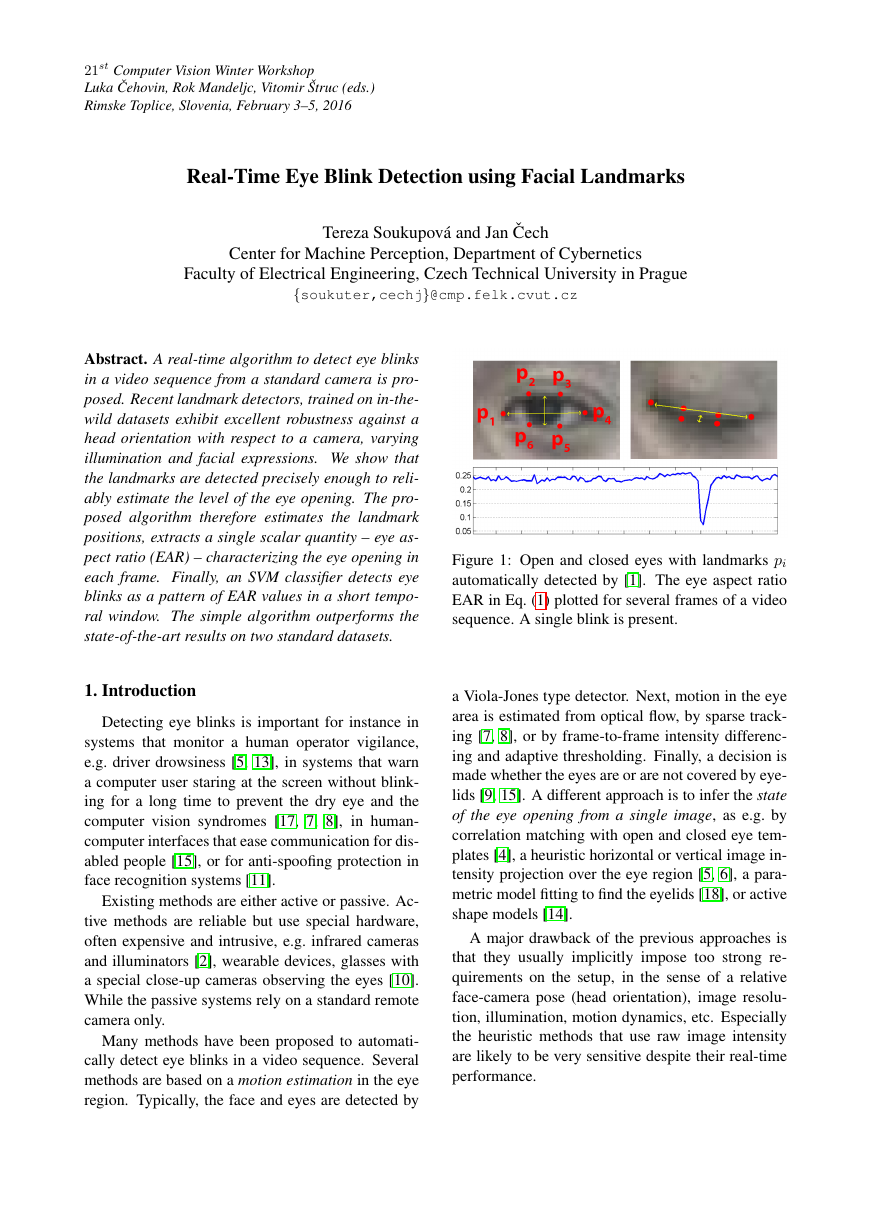
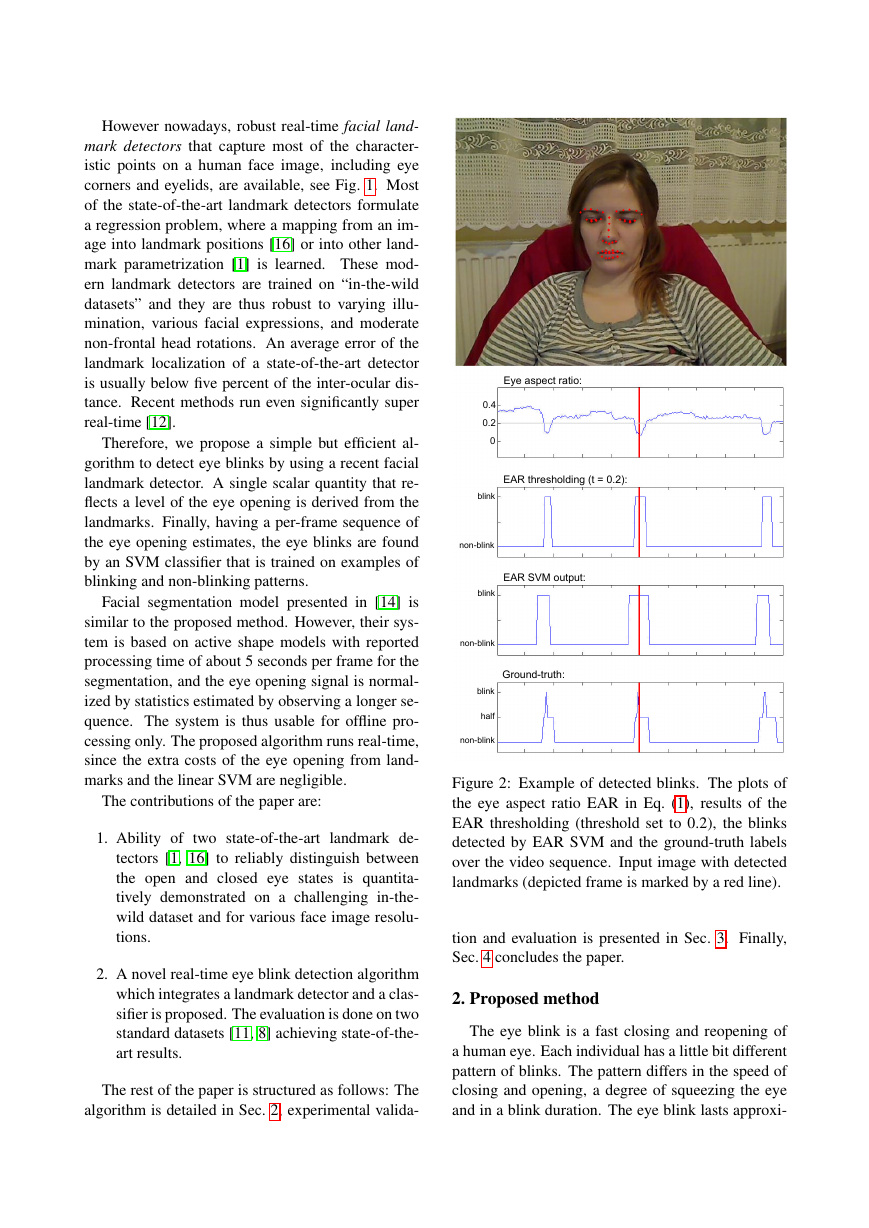


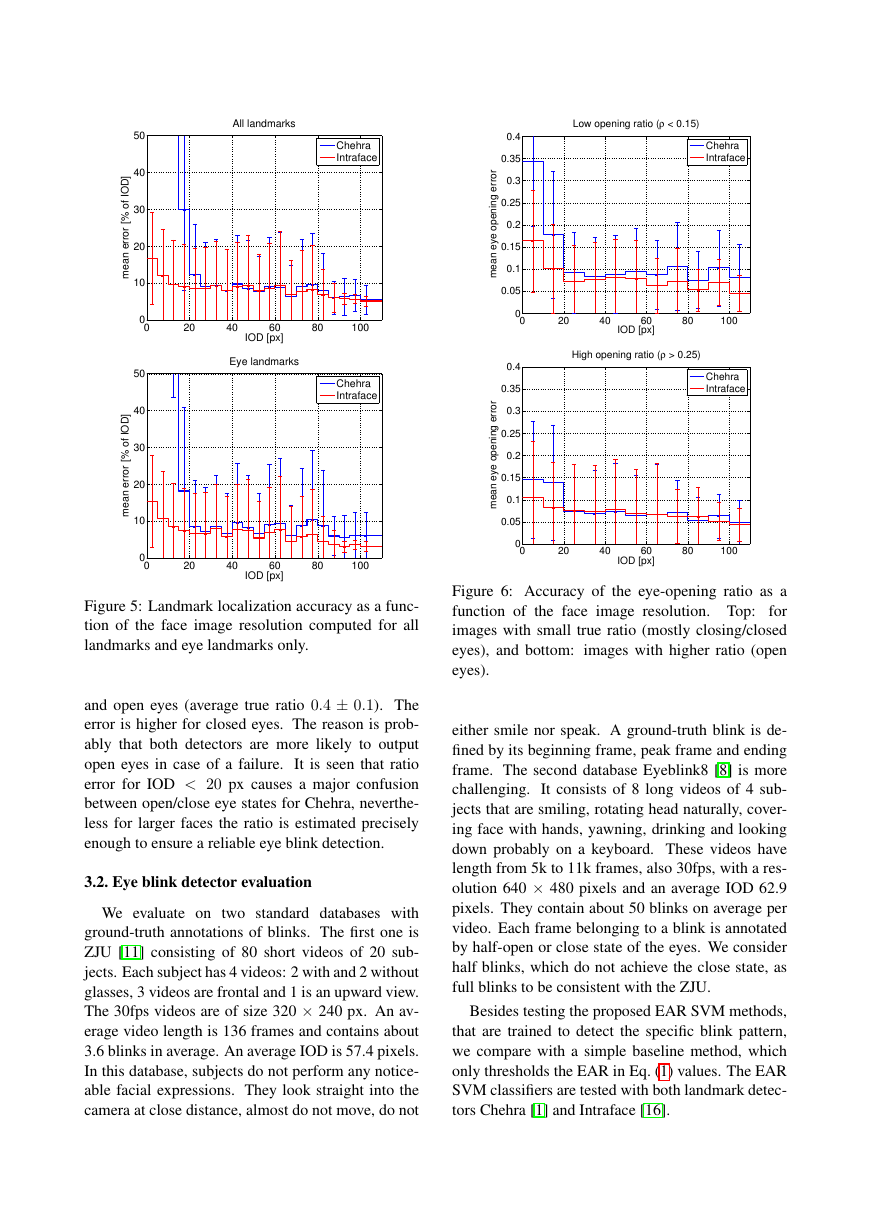
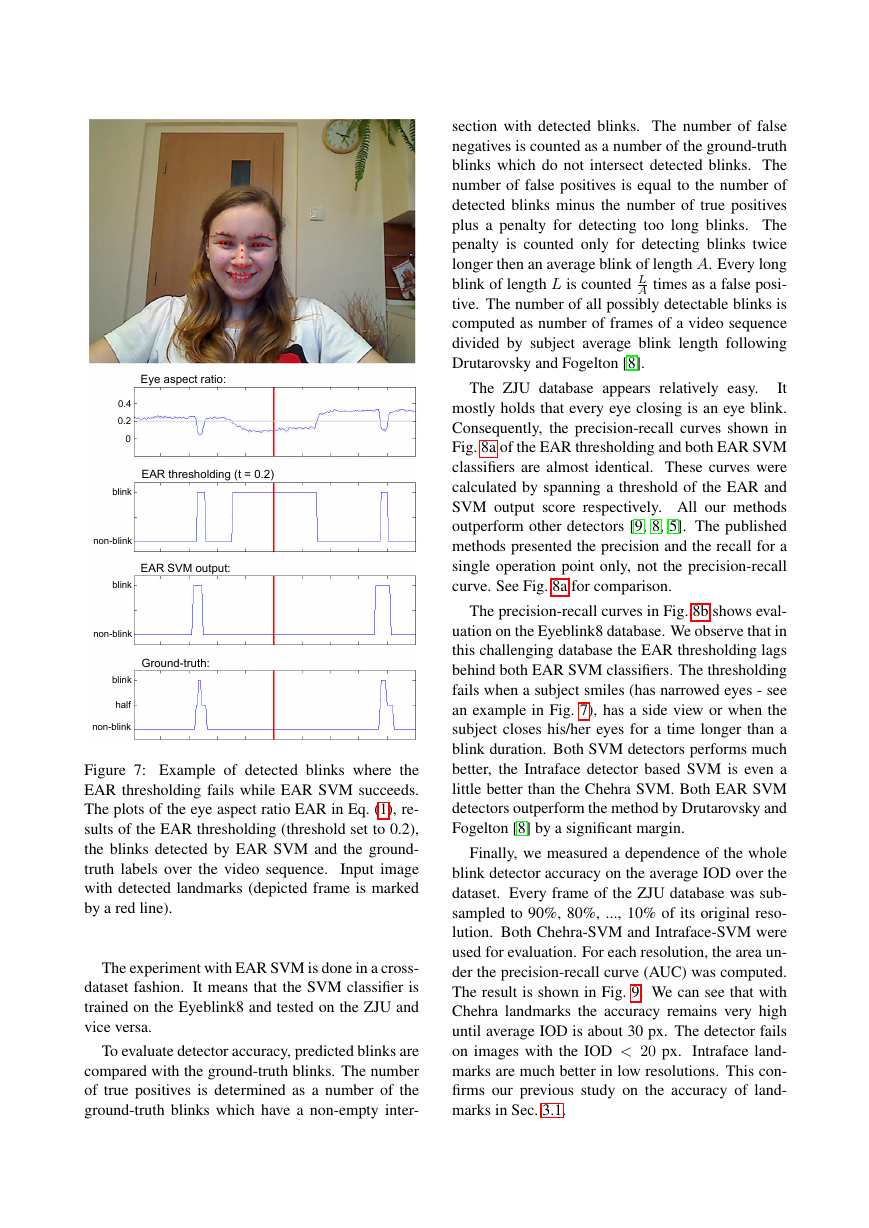
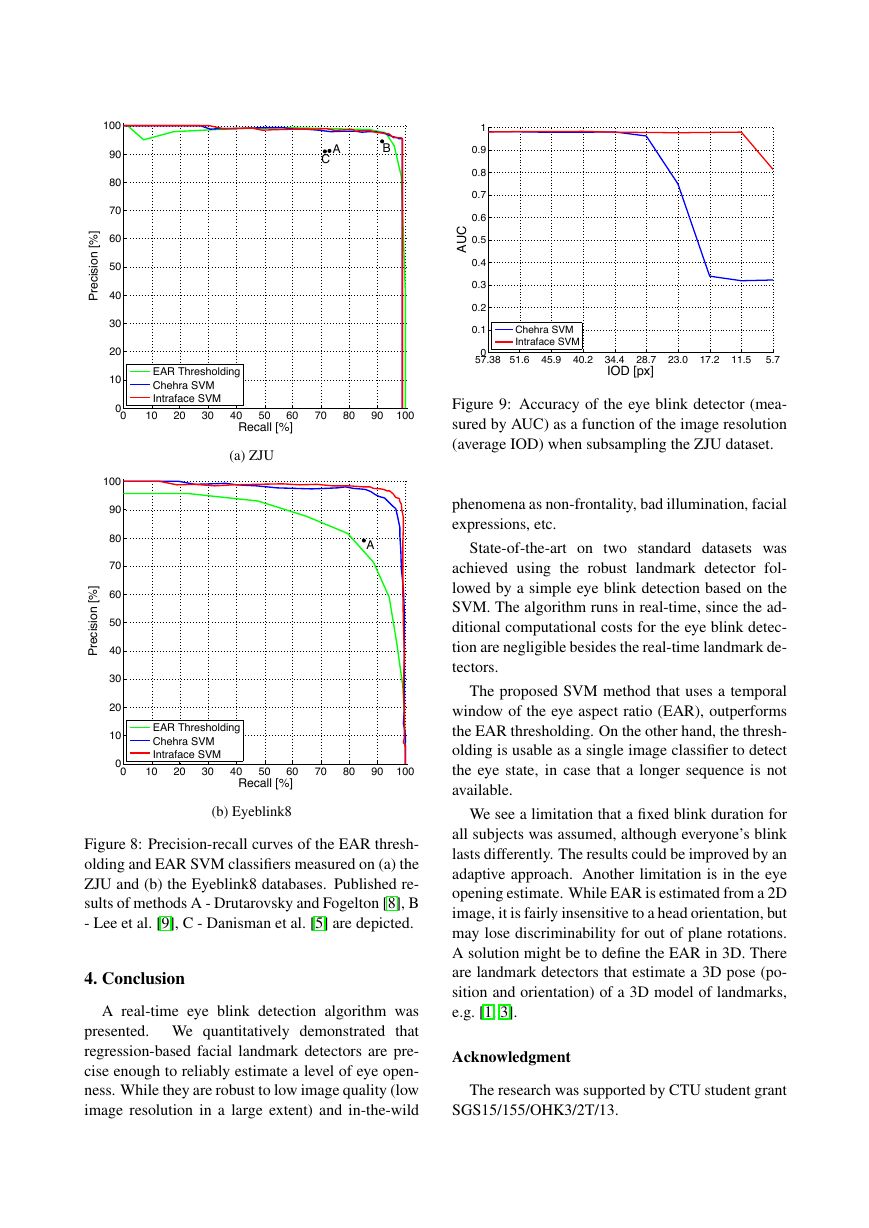
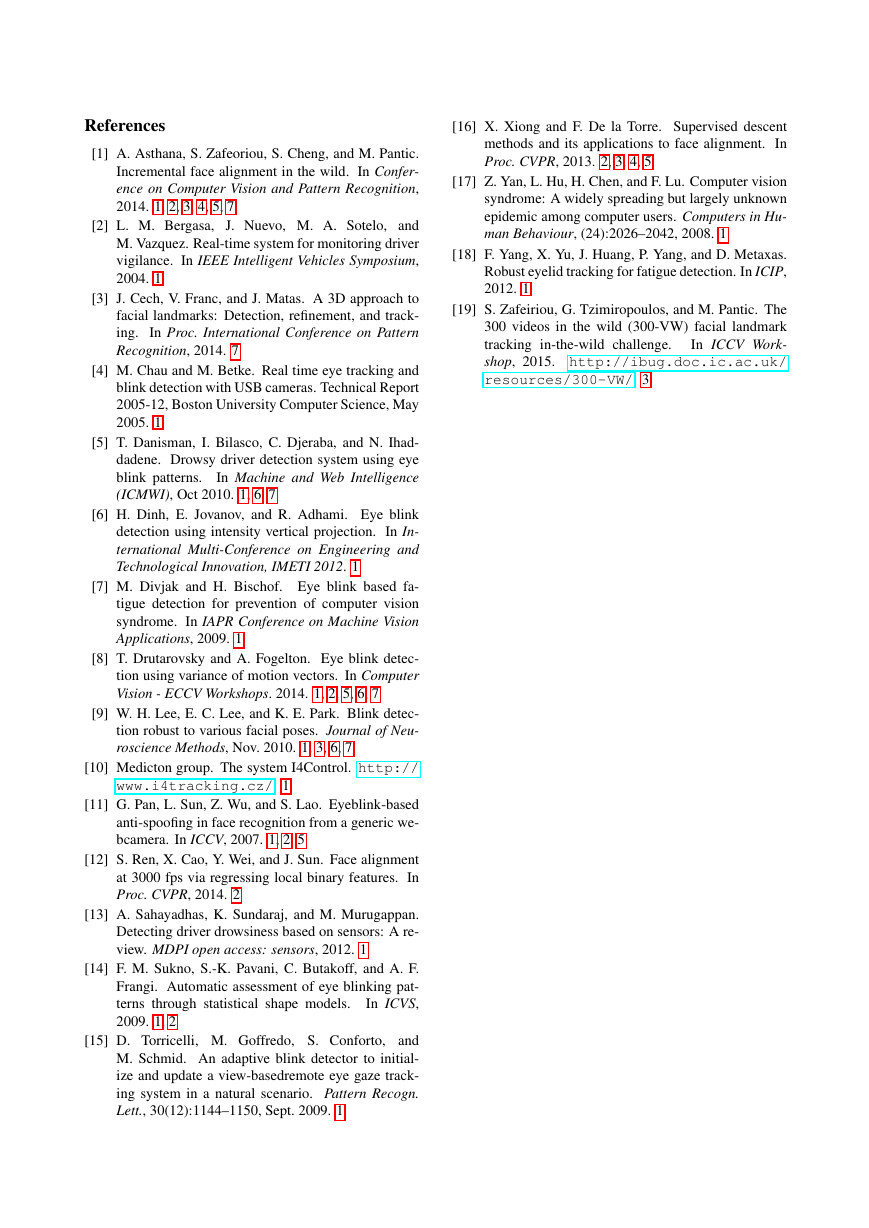








 2023年江西萍乡中考道德与法治真题及答案.doc
2023年江西萍乡中考道德与法治真题及答案.doc 2012年重庆南川中考生物真题及答案.doc
2012年重庆南川中考生物真题及答案.doc 2013年江西师范大学地理学综合及文艺理论基础考研真题.doc
2013年江西师范大学地理学综合及文艺理论基础考研真题.doc 2020年四川甘孜小升初语文真题及答案I卷.doc
2020年四川甘孜小升初语文真题及答案I卷.doc 2020年注册岩土工程师专业基础考试真题及答案.doc
2020年注册岩土工程师专业基础考试真题及答案.doc 2023-2024学年福建省厦门市九年级上学期数学月考试题及答案.doc
2023-2024学年福建省厦门市九年级上学期数学月考试题及答案.doc 2021-2022学年辽宁省沈阳市大东区九年级上学期语文期末试题及答案.doc
2021-2022学年辽宁省沈阳市大东区九年级上学期语文期末试题及答案.doc 2022-2023学年北京东城区初三第一学期物理期末试卷及答案.doc
2022-2023学年北京东城区初三第一学期物理期末试卷及答案.doc 2018上半年江西教师资格初中地理学科知识与教学能力真题及答案.doc
2018上半年江西教师资格初中地理学科知识与教学能力真题及答案.doc 2012年河北国家公务员申论考试真题及答案-省级.doc
2012年河北国家公务员申论考试真题及答案-省级.doc 2020-2021学年江苏省扬州市江都区邵樊片九年级上学期数学第一次质量检测试题及答案.doc
2020-2021学年江苏省扬州市江都区邵樊片九年级上学期数学第一次质量检测试题及答案.doc 2022下半年黑龙江教师资格证中学综合素质真题及答案.doc
2022下半年黑龙江教师资格证中学综合素质真题及答案.doc